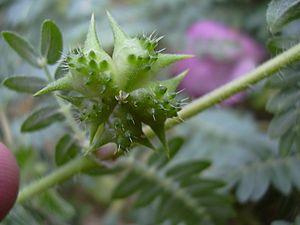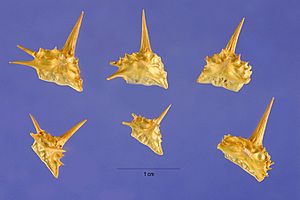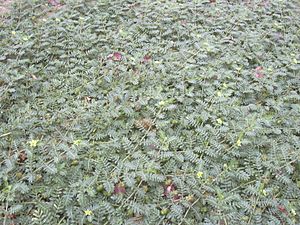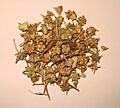Tribulus terrestris facts for kids
Quick facts for kids Tribulus terrestris |
|
|---|---|
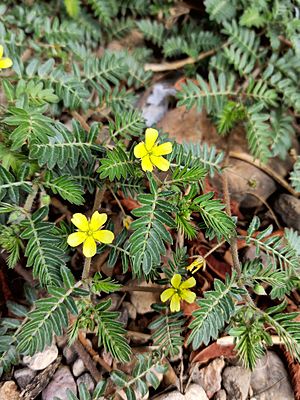 |
|
| Leaves and flower | |
| Scientific classification | |
| Genus: |
Tribulus
|
| Species: |
terrestris
|
| Varieties | |
|
|
Tribulus terrestris is a plant that grows every year. It belongs to the caltrop family. This plant is found all over the world. It can grow well in dry places where many other plants cannot survive. It originally comes from warm areas in southern Eurasia and Africa. It has also spread to North America and Australia by accident.
Tribulus terrestris is known as a harmful invasive species. This is because its small, woody fruit has long, sharp spines. These spines can easily poke through bare feet or thin shoes. They can also puncture bicycle tires. Grazing animals can get hurt in their mouths and on their skin.
Contents
What are its other names?
This plant has many common names. These names depend on where in the world you are. Some common names include goat's-head, bindii, bullhead, and caltrop. People also call it cat's-head, devil's-thorn, puncture vine, and tackweed.
What does it look like?
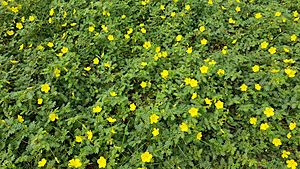
Tribulus terrestris is a plant with a main root that grows deep into the ground. It is a soft-stemmed plant that grows as an annual in places with mild weather. This means it completes its life cycle in one year.
How does it grow?
The stems of the plant spread out from the center. They can reach from about 10 centimeters to over 1 meter wide. These stems usually lie flat on the ground. They form flat patches. However, they might grow more upright if they are in the shade or among taller plants.
Leaves and stems
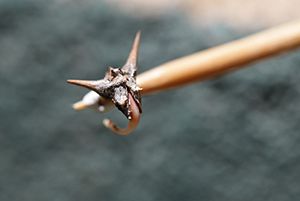
The stems grow from the center and are very hairy. The leaves grow opposite each other. They are made up of many smaller leaflets. These small leaflets are also very hairy. They can be up to 3 millimeters long.
Flowers
The flowers are small, about 4 to 10 millimeters wide. They have five bright yellow petals. They also have five sepals and ten stamens. In places like Southern California, the plant blooms from April to October. It grows very quickly in empty or disturbed areas.
Fruit and seed dispersal
After the flower blooms, a fruit grows. This fruit easily breaks into five separate burs. The burs are hard and have two to four sharp spines. These spines are about 10 millimeters long. They are 4 to 6 millimeters wide from point to point. The burs look a lot like a goat's or bull's head. This is why they have some of their common names.
The "horns" of the burs are sharp enough to puncture bicycle tires. They can also hurt bare feet. Livestock that eat the plant can get injured in their mouths. Inside each bur, seeds are stacked on top of each other. A hard membrane separates them. The largest seed usually sprouts first. The other seeds might wait until there is more water before they sprout. This helps the plant survive in dry places. The bur spines point upwards. They stick to the feet and fur of animals. This helps the plant spread its seeds to new places. But it can harm farm animals and damage their wool.
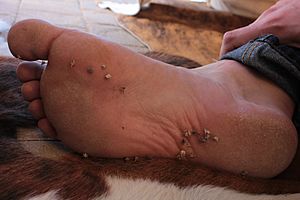
Where does it grow?
Tribulus terrestris is originally from the Mediterranean region. It is now found all over the world. It grows in warm areas of southern Europe, southern Asia, and all over Africa. You can also find it in New Zealand and Australia. It is common across the United States and in Central and South America. In the 1900s, it spread to California. It then moved north to places like the Okanagan Valley in British Columbia, Canada. There, it is considered a harmful weed.
The plant has many small roots that grow from its main root. These roots help it find water in the soil. This allows the plant to live in very dry conditions. It can grow in almost any soil. However, it grows best in dry, loose, sandy soils. It can even grow in sand or deserts. It can also grow in heavier soils, especially if they are rich or wet. You might also see it growing on hard ground along roadsides.
How do people use it?
This plant has spread naturally in the Americas and Australia. In some parts of the United States, it is considered a harmful and invasive species. The leaves and shoots of the plant are eaten in East Asia. The stems have been used to make thin buttermilk look thicker.
Dietary supplements
Some people use extracts from Tribulus terrestris as a dietary supplement. They believe it can increase testosterone levels, especially for bodybuilders. However, studies have shown that it does not increase testosterone. It has also not been proven to be safe. There is no proof that it makes people stronger or has effects like anabolic steroids.
How to get rid of it?
When this plant grows where it is not native, people often try to get rid of it. There are ways to control it using both physical methods and chemicals. However, no method works quickly and permanently. This is because the seeds of T. terrestris can stay alive for up to seven years.
Physical removal
For smaller areas, the best way to control T. terrestris is to remove it by hand. You can use a hoe to cut the plant at its main root. It is even better to pull out the whole plant, including the main root. This means you need to check the area and remove the weed before it produces seeds. This usually happens in late spring and early summer in many places. Doing this will greatly reduce how much of the weed grows the next year. Mowing does not work well because the plant grows flat against the ground.
Another way to control the plant is to plant other good plants. These plants can compete with T. terrestris for resources. Improving the soil and planting strong, desirable plants can help. This includes wide-leaved grasses like St. Augustine grass. This reduces the resources available for the weed.
In June 2014, a town in Oregon offered to pay people. They would pay one dollar for each large trash bag full of puncturevine.
Chemical control
Using chemicals is often suggested for controlling T. terrestris at home. There are some chemicals that can stop seeds from sprouting. These chemicals must be put down before the seeds sprout. This is usually from late winter to mid-spring.
Once the plants have grown out of the soil, other chemicals work well. Products with 2,4-D, glyphosate, and dicamba are effective. These chemicals work best when the plants are small and young. Dicamba and 2,4-D can harm most broad-leaved plants. So, you need to be careful not to use too much. They can be used on lawns without hurting the grass you want to keep. Glyphosate will kill or hurt most plants. So, it should only be used to treat small areas or where only the weed is growing.
Biological control
Two types of weevils were brought to the United States in 1961. They came from India, France, and Italy. These weevils are called Microlarinus lareynii and M. lypriformis. They are used to control the plant naturally. You can buy these weevils from special suppliers. However, it is not always suggested to buy and release them. Weevils from other areas might not survive where you live.
Microlarinus lareynii is a seed weevil. It lays its eggs in young burs or flower buds. The larvae (baby weevils) eat and destroy the seeds. Then they grow into adult weevils. The whole cycle takes about 19 to 24 days. Microlarinus lypriformis is a stem weevil. It has a similar life cycle. But it lays its eggs on the undersides of stems, branches, and the root crown. The larvae tunnel inside the plant's stem. They eat and grow there. Adult weevils of both types spend the winter in plant debris. The stem weevil works a bit better than the seed weevil when used alone. But both weevils are most effective when used together. They work even better if the T. terrestris plant is stressed from lack of water.
Can it be harmful?
The plant has compounds that can cause liver damage if animals eat too much of it. In sheep, eating T. terrestris can cause a disease called tribulosis. This is also known as 'geeldikkop'. It is a type of skin problem caused by light.
Images for kids
See also
 In Spanish: Abrojo para niños
In Spanish: Abrojo para niños


